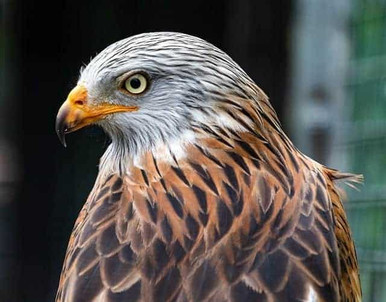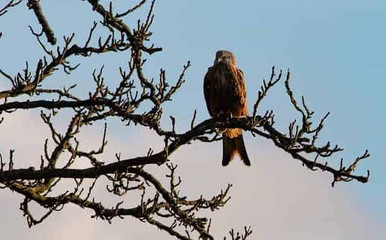The Ultimate Guide to the Red Kite
What is the Red Kite and what do they look like?
The Red Kite is a large, graceful bird of prey which can be easily recognised by their red/brown body, long angled wings, and forked tail. These birds can also be spotted by their elegant flying technique.

As their name suggests, they can be seen gliding through the air like a kite with their wings spread wide, searching for prey in the fields below or for small birds which they can grab from the air as they fly.
Their distinctive screeching call and bright bold feathers make it almost unmistakable and instantly recognisable. These birds of prey where saved from national extinction by a protection program after 2000 when the growing rate of self-sustaining breeding populations of Red Kites began to increase and expand across Britain. Now they have been successfully re-introduced back into England and Scotland.

Their rarity made them a target to bounty hunters and egg collectors who robbed up to a quarter of their nests each year. The increase of pesticides and insect repellents used on farms and in fields also became a serious cause of deaths to Kites in the UK. This ended up poisoning a vast number of these birds which consumed many of the insects and small rodents living among the crops and consuming this poison. This has made poisoning the number one most frequent cause of deaths in the UK.
What do Red Kites eat?
The Red Kite’s diet mainly consists of carrion, (dead animals that are easy to find) such as road kill. You can often spot them eating a dead carcass at the side of a road as they will frequently look for road kill as an easy food option. The Red Kite will also feed on other chicks and small birds, mammals and insects.
They sometimes catch live prey such as young gulls, crows and small rodents, however these animals take up a very small portion of their diet. Their most common live prey is earthworms.
Where does the Red Kite live?
This once rare bird of prey which could only be found in parts of Central Wales, has been successfully introduced back into many areas across the UK and can now be spotted in Yorkshire, Wales, Scotland, the East Midlands and the Chilterns. Red Kites don’t migrate so you can see them across the UK all year round.
The Red Kite can be seen around farms and fields. You can spot them high in the sky as the glide above trees and buildings. Listen out for their loud, distinctive screech as they soar. It’s easier to spot a Red Kite during mid-morning as they tend to hunt for prey at around this time of day.
Where do Red Kites nest?
Red Kites mainly build their nest high up in trees, sometimes in groups containing up to five other nests in the same tree. The Red Kite builds a large nest constructed from dried twigs, lined with grass and sheep’s wool. You can spot a Red Kite’s nest in a dense forest or up in tree branches by the edge of a farm or a field. They tend to build their nests very high of the ground. A few days before the Kite lays their eggs, they decorate the nest with rubbish and junk they find around on the ground.

They’ll search around for anything such as empty crisp packets, paper, carrier bags and even plastic toys to line the insides of their nests, and will continue using different materials to do so, until the breeding season is over. The nest of a Red Kite will keep growing and growing to a considerable size if used over several seasons.
The Female will lay up to 4 large brown/white speckled eggs in April. Once the mother has laid her clutch, she will refuse to leave them for more than a few minutes at a time until they hatch.
Once the eggs have hatched, the female will stay and take care of her young while the Male goes off to find food for her and her chicks, but only for the first 2 weeks of them hatching. After that, the mother will forage for food and leave the chicks to feed themselves from the scraps she leaves in the nest.
At about 50 to 70 days old, the young Kites will at last begin their fledgling period. Both their parents will care for them for about 15 to 20 days after this, at which time the young Red Kites will be ready to wander miles off, before they return to their birth place to start their own nests. They will typically breed for the first time at 2 years old. The Red Kite can reach to the age of around 10 years old before they die, however the oldest Kite recorded lived until it was 26.
What does a Red Kite’s call sound like?
Click on this link to hear what a Red Kite sounds like.
Red Kite Call
 As their name suggests, they can be seen gliding through the air like a kite with their wings spread wide, searching for prey in the fields below or for small birds which they can grab from the air as they fly.
Their distinctive screeching call and bright bold feathers make it almost unmistakable and instantly recognisable. These birds of prey where saved from national extinction by a protection program after 2000 when the growing rate of self-sustaining breeding populations of Red Kites began to increase and expand across Britain. Now they have been successfully re-introduced back into England and Scotland.
As their name suggests, they can be seen gliding through the air like a kite with their wings spread wide, searching for prey in the fields below or for small birds which they can grab from the air as they fly.
Their distinctive screeching call and bright bold feathers make it almost unmistakable and instantly recognisable. These birds of prey where saved from national extinction by a protection program after 2000 when the growing rate of self-sustaining breeding populations of Red Kites began to increase and expand across Britain. Now they have been successfully re-introduced back into England and Scotland.
 Their rarity made them a target to bounty hunters and egg collectors who robbed up to a quarter of their nests each year. The increase of pesticides and insect repellents used on farms and in fields also became a serious cause of deaths to Kites in the UK. This ended up poisoning a vast number of these birds which consumed many of the insects and small rodents living among the crops and consuming this poison. This has made poisoning the number one most frequent cause of deaths in the UK.
Their rarity made them a target to bounty hunters and egg collectors who robbed up to a quarter of their nests each year. The increase of pesticides and insect repellents used on farms and in fields also became a serious cause of deaths to Kites in the UK. This ended up poisoning a vast number of these birds which consumed many of the insects and small rodents living among the crops and consuming this poison. This has made poisoning the number one most frequent cause of deaths in the UK.
 They’ll search around for anything such as empty crisp packets, paper, carrier bags and even plastic toys to line the insides of their nests, and will continue using different materials to do so, until the breeding season is over. The nest of a Red Kite will keep growing and growing to a considerable size if used over several seasons.
The Female will lay up to 4 large brown/white speckled eggs in April. Once the mother has laid her clutch, she will refuse to leave them for more than a few minutes at a time until they hatch.
Once the eggs have hatched, the female will stay and take care of her young while the Male goes off to find food for her and her chicks, but only for the first 2 weeks of them hatching. After that, the mother will forage for food and leave the chicks to feed themselves from the scraps she leaves in the nest.
At about 50 to 70 days old, the young Kites will at last begin their fledgling period. Both their parents will care for them for about 15 to 20 days after this, at which time the young Red Kites will be ready to wander miles off, before they return to their birth place to start their own nests. They will typically breed for the first time at 2 years old. The Red Kite can reach to the age of around 10 years old before they die, however the oldest Kite recorded lived until it was 26.
They’ll search around for anything such as empty crisp packets, paper, carrier bags and even plastic toys to line the insides of their nests, and will continue using different materials to do so, until the breeding season is over. The nest of a Red Kite will keep growing and growing to a considerable size if used over several seasons.
The Female will lay up to 4 large brown/white speckled eggs in April. Once the mother has laid her clutch, she will refuse to leave them for more than a few minutes at a time until they hatch.
Once the eggs have hatched, the female will stay and take care of her young while the Male goes off to find food for her and her chicks, but only for the first 2 weeks of them hatching. After that, the mother will forage for food and leave the chicks to feed themselves from the scraps she leaves in the nest.
At about 50 to 70 days old, the young Kites will at last begin their fledgling period. Both their parents will care for them for about 15 to 20 days after this, at which time the young Red Kites will be ready to wander miles off, before they return to their birth place to start their own nests. They will typically breed for the first time at 2 years old. The Red Kite can reach to the age of around 10 years old before they die, however the oldest Kite recorded lived until it was 26.
